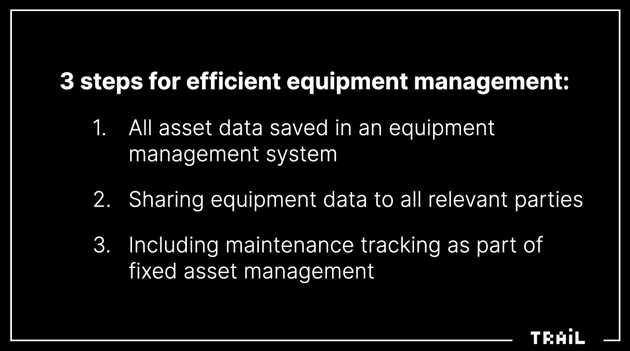Three steps for enhancing equipment management of a city?
The daily activities of a city require a wide variety of fixed assets. There are lawn-movers for the parks department, ski track makers for the exercise department, presentation technology for cultural services, school equipment, video projectors, computers, theatre props… Assets gradually accumulate in different locations and storages around the municipality, and there is a huge amount of money tied to this equipment. In order to get value for the appropriations spent on the equipment, the city's equipment should be used as efficiently as possible.
The cornerstone underlying the efficient use of the city’s fixed assets is the transparency of asset data. Only this will guarantee that the city organization can use the equipment in the best possible way and utilize accurate measuring data related to the equipment in decision-making. This blog text examines more closely how asset data can be made available to the entire city organization and what measures are required to guarantee efficient equipment management.
Step 1: All asset data saved in an equipment management system
The first step to managing a city’s fixed assets is to combine all asset data. Data concerning movables has most certainly been collected during inventories, but this data is typically scattered across multiple Excel files and folders. The problem is that scattered files and papers will not remain up-to-date for long and are therefore not very reliable. In order to guarantee the currency of asset data, it should be listed in an electronic equipment management system that enables easy updating.
Excel files and lists on paper also involve another significant drawback. Sharing them in a practical way to all of the relevant individuals is impossible. An Excel file on the internet can certainly be made available to many people, but the more people have a right to edit the Excel file, the more vulnerable it becomes to human error. Moreover, an Excel file in the depths of the internet or a folder lying in an office cabinet is not very easy to find.
Step 2: Sharing equipment data to all relevant parties
Once the asset data has been entered in an updated system, the data must be shared to all of the relevant individuals. In practice, this means all city personnel who use equipment or who have a need to use the fixed assets in the system.
When the city employees can see all of the available equipment, they have a better chance to also use it. This will improve the degree of equipment utilization. At best, the city can avoid unnecessary equipment rentals and acquisitions.
Let’s explain this using a typical situation: One of the cultural venues of the city needs more spotlights for an upcoming event. Instead of the Production Manager of the cultural venue making phone calls to other venues (which may not immediately remember whether their equipment is available or not…) or renting spotlights from a third party, the Manager can open the city’s equipment management system and search for the required spotlights there. If spotlights are available in another venue during the time of the event, the Manager can reserve the spotlights. This will save time and the degree of equipment utilization will improve.
Of course, transparency has its limitations. A Production Manager working for the cultural services does not necessarily need to see the leaf blowers of the parks department. This is why it is important that the equipment data is categorized according to the different organizations within the city so that users will only have access to the data that they need.
However, the city management needs an overview of the assets owned by the city. Budgeting becomes significantly easier when the value of movable fixed assets can be discovered without having to gather fragmented information from multiple sources. The usage, maintenance and acquisition history of equipment will also help to make better investment decisions. When decisions are based on more accurate data, appropriations are put to better use.
Step 3: Maintenance Tracking as Part of Fixed Asset Management
Many of the city’s movables involve various maintenance obligations. Maintenance needs arise when equipment breaks down or requires maintenance and inspections at regular intervals. Some of the city’s equipment may even involve statutory inspections.
A key element of a city’s asset management is equipment maintenance tracking. Maintenance undertaken on an individual piece of equipment should be recorded in the equipment data so that this information will be easily accessible by all of the relevant individuals in the future.
A modern fixed asset management system enables the marking of movables with barcodes, QR codes, NFC tags or RFID tags, which also makes it easy to access the equipment data by scanning these labels. Typically, scanning a label will also allow the user to report any defects concerning the equipment so that maintenance can begin without delay.
Summary
Tracking fixed assets owned by a city organization is demanding, but accurate tracking produces important data that can be utilized to improve decision-making. When decisions are based on data instead of guesses, resources can be used more sensibly. If a city wishes to manage fixed assets as efficiently as possible, it needs to use a versatile fixed asset management system, which can include all of the city’s equipment, consumables and personnel, if needed.
However, implementing ideal fixed asset management on a city-level does not happen overnight. It is a gradual process that proceeds according to these steps:
- Compiling fixed assets into one system
- Sharing asset data to all of the relevant individuals
- Managing equipment maintenance as part of fixed asset management
The most sensible way to proceed is to first set up the fixed asset management of one of the city’s organizations, collect experiences, make improvements to the process and then replicate the model elsewhere. Time should also be reserved for personnel training, because fixed asset management typically requires a change to the work culture and methods.
If you want to hear more about the best practices of fixed asset management in cities and how equipment and the related information can best be utilized throughout the city, contact us. We would be happy to tell you more.

